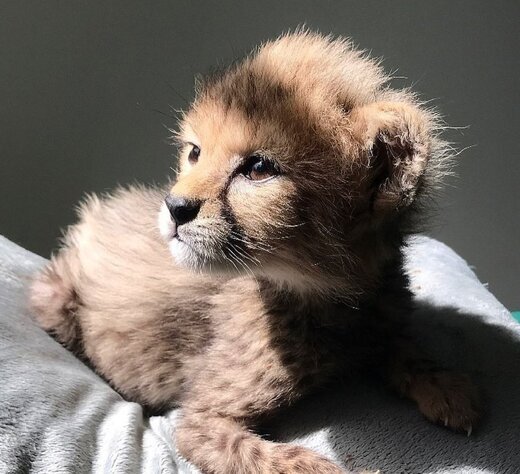Pirouz paws touched the soil for first time

TEHRAN – The lone surviving Asiatic cheetah cub, named “Pirouz” meaning “victorious” in Farsi, for the first time touched the soil outside and started playing.
An endangered female cheetah, called “Iran”, gave birth to three cubs in captivity, for the first time for the subspecies. The cubs were born at the Touran Wildlife Refuge in Semnan province, on May 1st, by cesarean section.
However, one of the cubs who were weaker lost his life in the early days, and after a while, the second cub also died due to improper care.
Listed as critically endangered by the IUCN, the Asiatic cheetah is among the rarest cats in the world at the subspecies level. The lone surviving cub seems to be healthy and agile.
The Department of Environment (DOE) was preparing an outdoor site to familiarize "Pirouz" with sunlight and outdoor air. Then move him to his main habitat in Touran Wildlife Refuge in early November.
"Pirouz" was not supposed to be released into nature and live among wildlife, due to many problems that still bring a lot of worries, even if he was born naturally and was fed by his mother, Gholamreza Ebdali, head of the wildlife protection and management office of the DOE, said.
The cubs born in captivity must be tamed and trained and have no fear of humans so that they can be easily diagnosed without anesthesia on special occasions when blood sampling is needed, he stated.
Hassan Akbari, deputy head of the Department of Environment (DOE), said in January that the Asiatic Cheetah was down to just 12, from an estimated 100 in 2010.
The cheetah habitat in the southern part of the country is stretching to over three million hectares but is hosting only a few cheetahs.
The DOE has long been trying to breed Asiatic cheetah in the wild and in captivity so that the species is protected from extinction, but none appeared successful.
Previously, artificial insemination has been conducted on a female cheetah called ‘Delbar’ several times, and all failed.
Fastest mammal endangered
Over the past 60 years, Iran is home to the last known population of Asiatic cheetah, which once roamed across vast ranges of the west and south Asian countries, from West Asia to India. Listed as critically endangered by the IUCN, the Asiatic cheetah is among the rarest cats in the world at the subspecies level, with fewer than 50 believed to remain in Iran.
In Iran, the cheetah is also bound to cultural and social meanings. In 2014, the Iranian national football team announced that their 2014 FIFA World Cup and 2015 AFC Asian Cup kits are imprinted with pictures of the Asiatic cheetah to bring attention to conservation efforts.
In February 2015, Iran launched a search engine, Yooz, that features a cheetah as the logo. And it all shows that cheetahs and Pirouz are now more important than ever — and became part of our Iranian culture and are embedded in our daily life.
Cheetahs’ habitats in Iran are stretching over 12 million hectares of land area and over the past 16 years, only experts collaborating with the Conservation of Asiatic Cheetah Project (CACP project) have strived to count 48 cheetahs using trap cameras and other technical methods.
Roads fragmenting cheetahs’ habitats are the main threats to the species, while guard dogs and stray dogs, drought spells, decreasing population of the prey species to support the cheetahs, and habitat loss are also other factors endangering the sparse population of the cheetahs in the country.
FB/MG
Leave a Comment